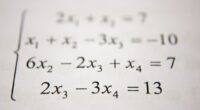Float is a smaller data type than double, which means it can’t store as much information. However, Float is faster than double, so it’s often used when speed is more important than accuracy.
Float and Double in Computer Science
(Photo by AltumCode on Unsplash )

In computer science, “float” and “double” are two data types used to represent floating-point numbers. A floating-point number is a type of numeric value that has a decimal point, allowing for a much wider range of values than integers.
The main difference between “float” and “double” is the size of the values they can represent and the precision with which they represent those values.
“Float” is a single-precision floating-point data type, which means it uses 32 bits of memory to store a value. This provides a range of values that can be represented, but with relatively low precision. As a result, “float” values can have rounding errors and may not be suitable for applications that require high precision.
“Double” is a double-precision floating-point data type, which means it uses 64 bits of memory to store a value. This provides a much wider range of values that can be represented, and with much greater precision. As a result, “double” values are typically used for applications that require high precision, such as scientific and financial computations.
In general, when working with floating-point numbers, it’s important to choose the appropriate data type based on the range of values and the precision required for a specific application. Using the wrong data type can lead to unexpected results and errors.
What is a float?
A float is a data type that represents a real number in floating-point form. A floating-point number typically has four parts: the sign bit, the exponent, the mantissa, and the radix point. The mantissa stores the significant digits of the number, and the exponent dictates how those digits are to be interpreted. The radix point is also sometimes known as the decimal point.
A “float” is a data type used in computer programming to represent floating-point numbers. A floating-point number is a type of numeric value that has a decimal point, allowing for a much wider range of values than integers.
The “float” data type is a single-precision floating-point data type, which means it uses 32 bits of memory to store a value. This provides a range of values that can be represented, but with relatively low precision.
“Float” values can be positive or negative and can represent a wide range of values, including very small and very large numbers. However, because they have limited precision, they can have rounding errors and may not be suitable for applications that require high precision.
When working with “float” values, it’s important to be aware of the limitations of the data type and to choose it appropriately for a specific application. In some cases, you may need to use a double-precision floating-point data type, such as “double,” if greater precision is required.
A float is typically written in computer programming languages as a decimal number with a decimal point and/or an exponent. The general syntax for writing a float in most programming languages is:
value = decimal_part . fractional_part
For example, the float value of 1.23 would be written as:
value = 1.23
In some programming languages, you can also write a float in exponential notation, which is useful for representing very small or very large numbers. The general syntax for writing a float in exponential notation is:
value = decimal_part x 10^exponent
For example, the float value of 1.23 x 10^-3 would be written as:
value = 1.23e-3
It’s worth noting that the syntax for writing floats can vary slightly between programming languages. It’s a good idea to consult the documentation for the specific language you’re using to ensure that you’re writing floats correctly.
What is a double?
A “double” is a data type used in computer programming to represent floating-point numbers. A floating-point number is a type of numeric value that has a decimal point, allowing for a much wider range of values than integers.
The “double” data type is a double-precision floating-point data type, which means it uses 64 bits of memory to store a value. This provides a much wider range of values that can be represented, and with much greater precision, compared to single-precision floating-point data types such as “float”.
“Double” values can be positive or negative and can represent a wide range of values, including very small and very large numbers. Because they have greater precision, they are often used in applications that require high precision, such as scientific and financial computations.
When working with “double” values, it’s important to be aware of the limitations of the data type and to choose it appropriately for a specific application. In some cases, you may need to use a different data type, such as “float,” if lower precision is sufficient.
How is a double typically written?
A double is typically written in computer programming languages in the same way as a float, as a decimal number with a decimal point and/or an exponent. The general syntax for writing a double in most programming languages is:
value = decimal_part . fractional_part
For example, the double value of 1.23 would be written as:
In some programming languages, you can also write a double in exponential notation, which is useful for representing very small or very large numbers. The general syntax for writing a double in exponential notation is:
value = decimal_part x 10^exponent
For example, the double value of 1.23 x 10^-3 would be written as:
value = 1.23e-3
It’s worth noting that the syntax for writing doubles can vary slightly between programming languages. It’s a good idea to consult the documentation for the specific language you’re using to ensure that you’re writing doubles correctly.
How is a double and a float different?
A float and a double are both data types used in computer programming to represent floating-point numbers, but they differ in the amount of memory they use to store a value and the precision of the values they can represent.
A float is a single-precision floating-point data type, which uses 32 bits of memory to store a value. This provides a range of values that can be represented, but with relatively low precision.
A double, on the other hand, is a double-precision floating-point data type, which uses 64 bits of memory to store a value. This provides a much wider range of values that can be represented, and with much greater precision, compared to float.
In terms of precision, a float can represent numbers with approximately 7 decimal digits of precision, while a double can represent numbers with approximately 15 decimal digits of precision. This means that double provides a much higher level of precision than float, making it a better choice for applications that require high precision, such as scientific and financial computations.
However, it’s important to note that while a double has greater precision than a float, it also uses more memory, which can impact performance. When choosing between float and double, it’s important to consider the specific requirements of your application and to choose the data type that provides the right balance of precision and memory usage for your needs.
When to use a float or double?
The choice between using a float or a double in a computer program depends on the specific requirements of the application. Here are some guidelines to help you decide when to use a float or a double:
Use float when:
- Lower precision is sufficient for your application.
- You need to save memory. Since a float uses less memory than a double, using float can help reduce the memory footprint of your program, which can be especially important for mobile or embedded systems with limited memory resources.
- You’re working with performance-critical code and you need to minimize the memory and processing overhead.
Use double when:
- Higher precision is required for your application.
- You’re working with scientific or financial computations that require a high level of precision.
- You’re working with large or very small numbers that require a wide range of representable values.
Some programming languages may provide additional floating-point data types, such as long double, that provide even greater precision than double. In these cases, you can choose between float, double, and long double depending on the specific requirements of your application.
Ultimately, the choice between using a float or a double will depend on the specific needs of your application and the trade-offs between precision, memory usage, and performance. It’s important to choose the data type that provides the right balance of these factors for your needs.
How to convert a float to a double?
In most programming languages, converting a float to a double is a straightforward process, as the double data type can represent a wider range of values and with higher precision than the float data type. Here’s how you can convert a float to a double in a few popular programming languages:
C:
float my_float = 1.23f;
double my_double = (double) my_float;
Java:
float my_float = 1.23f;
double my_double = my_float;
Python
my_float = 1.23
my_double = float(my_float)
C#
float my_float = 1.23f;
double my_double = (double) my_float;
In these examples, the float value is explicitly cast to a double using a type conversion operator, such as (double) in C and C#, or implicitly cast to a double in Java and Python. Once the float value has been converted to a double, it can be used just like any other double value in your program.
It’s important to note that casting a float to a double may result in a loss of precision, as the double data type has a greater range and precision than the float data type. However, this is generally not an issue in most practical applications, as the loss of precision is typically small and the increased precision of the double data type is often more important.
Featured Image By – Radowan Nakif Rehan on Unsplash








